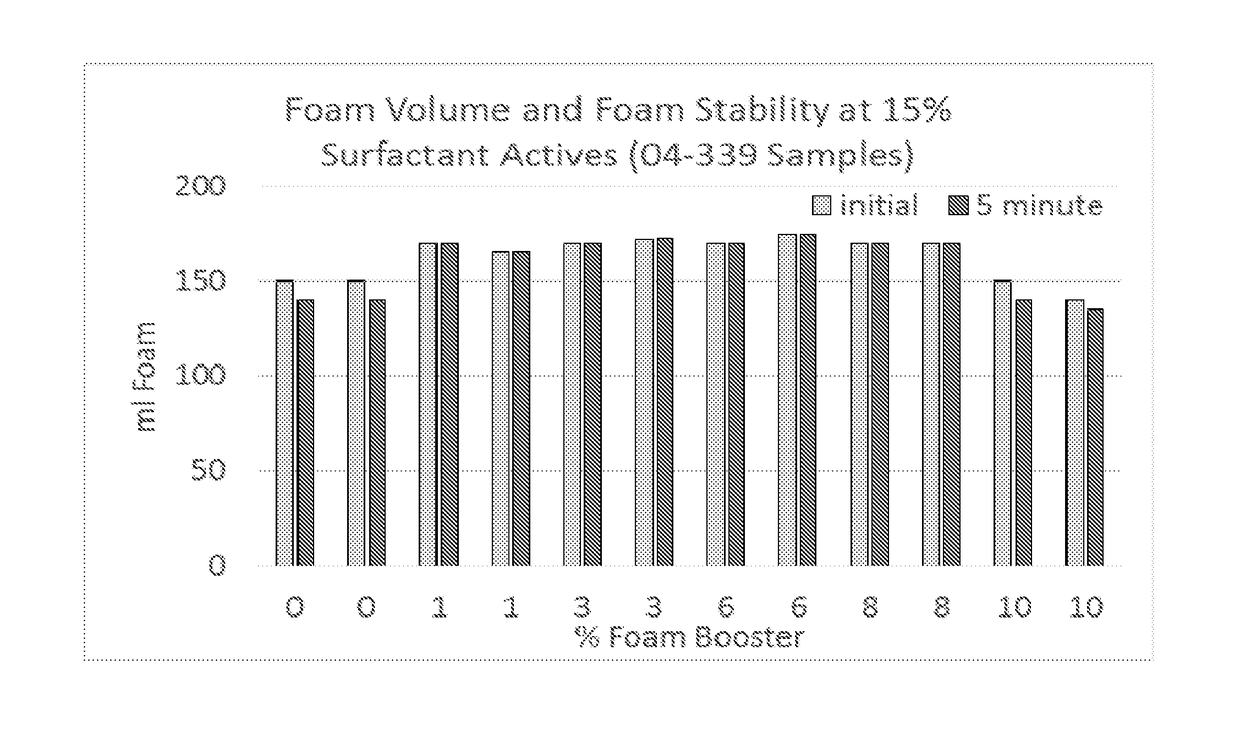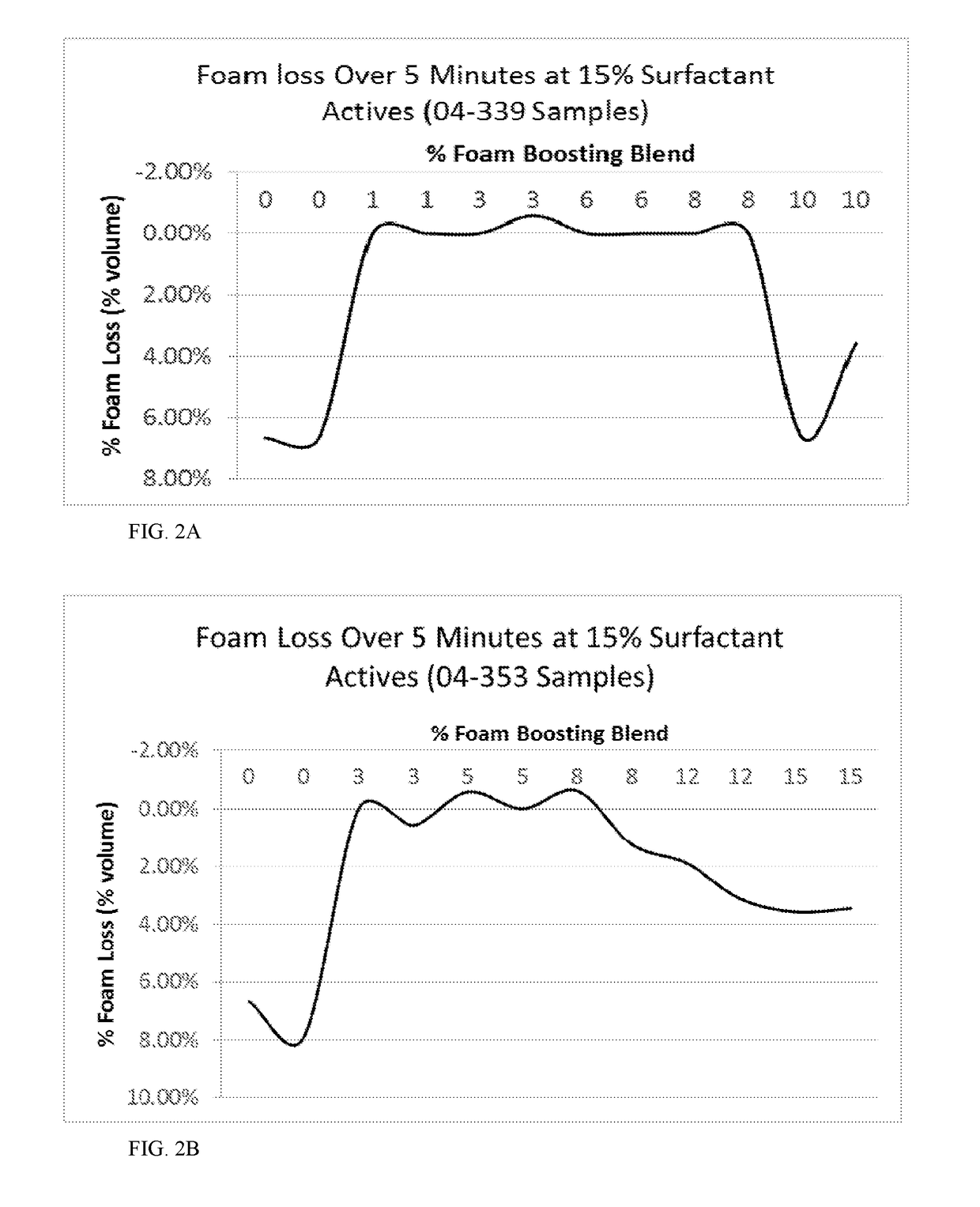Foam boosting saccharide blend
a saccharide and blend technology, applied in the field of foamable compositions, can solve the problems of not all foams are not every surfactant or foaming agent is suitable for all applications, and the foaming power of foamable compositions is lost, so as to overcome deficiencies in the art, and enhance the foaming capability
- Summary
- Abstract
- Description
- Claims
- Application Information
AI Technical Summary
Benefits of technology
Problems solved by technology
Method used
Image
Examples
example 1
Method of Making a Foam Boosting Saccharide Blend
[0066]A foam boosting blend was prepared by combining at a 1:1 ratio FARMAL® HFS 2656 and FARMAL® GS 1653. FARMAL® HFS 2656 and FARMAL® GS 1653 are both commercially available from Ingredion and are aqueous solutions of carbohydrates produced through the hydrolysis of corn starch. FARMAL® HFS 2656 and FARMAL® GS 1653 have the characteristics disclosed in Table 1.
[0067]
TABLE 1Density (kg / liter)Viscosity (cps)DryAppearancev. Temperaturev. TemperatureSubstance %pH (as is)FARMAL ®clear, slightly 1.379 at 80° F. 700 at 80° F.76.8 to 77.43.5 to 4.3HFS2656viscous1.372 at 100° F.250 at 100° F.liquid1.367 at 120° F.100 at 120° F.Carbohydrate Profile, % d.b.Fructose55Dextrose + Fructose>95.0Higher Saccharides(with at least 2 monosaccharide units)Density (kg / liter)Viscosity (cps)DryDextroseAppearancev. Temperaturev. TemperatureSubstance %EquivalentFARMAL ®clear, 1.421 at 80° F.20000 at 80° F.81.0 to 82.760.0 to 67.0GS 1653viscous1.415 at 100° F....
example 2
Testing the Foam Boosting Blend
[0078]The foam boosting blend (Batch C from Table 2) was added into the foamable formulations described in Tables 3 and 4 by adding the foam boosting blend into the formula via mixing and adjusting the level of aqueous sodium hydroxide used to account for pH drift caused by the boosting blend (i.e., q.s down with aqueous sodium hydroxide). These formulations were tested to determine foam power and foam stability of these formulations with (3 wt. %) and without (0 wt. %) the foam booster.
[0079]
TABLE 3% ConcentrationIngredient(by weight)Phase AWater44Synthalen ® W600 (Acrylates Copolymer)10COAB (Chembetaine ™ C Surfactant30(Cocamidopropyl Betaine)LG-1250 (Endinol ® MILD CC-1250 (Coco-10Glucoside)NaOH 25% w / w (Sodium Hydroxide)q.s.Phase BOlivatis ™ 15 (Olive Oil Glycereth-8 Esters)2Fragrance Oil (Ultrapure Lavender Oil (Lavandula3Angustifolia (Lavender) Oil) and PeppermintEssential Oil (Mentha Piperita (Peppermint) Oil)Phase CPreservative(Sharomix ™ CPP (...
example 3
Stability Testing of a Shampoo Having the Foam Boosting Blend
[0086]Foam boosting blend from Batch C, Table 2, were added to shampoo formulations based on the ingredient list described in Table 5 below by adding the foam boosting blend into the formula via mixing and adjusting the water to account for the boosting blend (i.e., q.s down with water). The addition of the foam boosting blend provided an observable increase in flash foam, followed by a loose to medium density foam upon contact with water characterized at that point as a stable foam with a longer retention time than expected.
[0087]
TABLE 5*% ConcentrationIngredient(by weight)Phase AWater36Dissolvin ® GL-47-S (Tetrasodium Glutamate0.2Diacetate)Synthalen ® W600 (Acrylates Copolymer)10Phase BChembetaine ™ C Surfactant (Cocamidopropyl25Betaine)Endinol ® MILD CC-1250 (Coco-Glucoside)10Safflower Oil (Carthamus tinctorius (Safflower)3Seed Oil)Phase COlivatis ™ 15 (Olive Oil Glycereth-8 Esters)2Ultrapure Lavender Oil (Lavandula Ang...
PUM
| Property | Measurement | Unit |
|---|---|---|
| wt. % | aaaaa | aaaaa |
| wt. % | aaaaa | aaaaa |
| wt. % | aaaaa | aaaaa |
Abstract
Description
Claims
Application Information
 Login to View More
Login to View More - R&D
- Intellectual Property
- Life Sciences
- Materials
- Tech Scout
- Unparalleled Data Quality
- Higher Quality Content
- 60% Fewer Hallucinations
Browse by: Latest US Patents, China's latest patents, Technical Efficacy Thesaurus, Application Domain, Technology Topic, Popular Technical Reports.
© 2025 PatSnap. All rights reserved.Legal|Privacy policy|Modern Slavery Act Transparency Statement|Sitemap|About US| Contact US: help@patsnap.com



